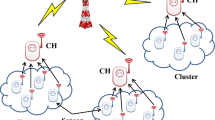Abstract
In this paper, we have proposed and designed DPHK (data prediction based on HMM according to activity pattern knowledge mined from trajectories), a real-time distributed predicted data collection system to solve the congestion and data loss caused by too many connections to sink node in indoor smart environment scenarios (like Smart Home, Smart Wireless Healthcare and so on). DPHK predicts and sends predicted data at one time instead of sending the triggered data of these sensor nodes which people is going to pass in several times. Firstly, our system learns the knowledge of transition probability among sensor nodes from the historical binary motion data through data mining. Secondly, it stores the corresponding knowledge in each sensor node based on a special storage mechanism. Thirdly, each sensor node applies HMM (hidden Markov model) algorithm to predict the sensor node locations people will arrive at according to the receivedmessage. At last, these sensor nodes send their triggered data and the predicted data to the sink node. The significances of DPHK are as follows: (a) the procedure of DPHK is distributed; (b) it effectively reduces the connection between sensor nodes and sink node. The time complexities of the proposed algorithms are analyzed and the performance is evaluated by some designed experiments in a smart environment.
Similar content being viewed by others
References
Guo S, Yang Y. A distributed optimal framework for mobile data gathering with concurrent data uploading in wireless sensor networks. In: Proceedings of IEEE INFOCOM. 2012, 1305–1313
Seino W, Yoshihisa T, Hara T, Nishio S. A sensor data collection method with a mobile sink for communication traffic reduction by delivering predicted values. In: Proceedings of the 26th IEEE International Conference on Advanced Information Networking and Applications Workshops. 2012, 613–618
Kulik L, Tanin E, Umer M. Efficient data collection and selective queries in sensor networks. Lecture Notes in Computer Science, 2008, 4540: 25–44
Durmaz Incel O, Ghosh A, Krishnamachari B, Chintalapudi K. Fast data collection in tree-based wireless sensor networks. IEEE Transactions on Mobile Computing, 2012, 11(1): 86–99
Cheng B, Xu Z, Chen C, Guan X. Spatial correlated data collection in wireless sensor networks with multiple sinks. In: Proceedings of 2011 IEEE Conference on Computer Communications Workshops. 2011, 578–583
Wang C, De D, Song W. Trajectory mining from anonymous binary motion sensors in smart environment. Knowledge-Based Systems, 2013, 37: 346–356
Hasan M, Rubaiyeat H, Lee Y, Lee S. Mapping of activity recognition as a distributed inference problem in sensor network. In: Proceedings of the 2008 International Conference on Artificial Intelligence. 2008, 280–285
Yu G, Yuan J, Liu Z. Predicting human activities using spatiotemporal structure of interest points. In: Proceedings of the 20th ACM International Conference on Multimedi. 2012, 1049–1052
Tastan B, Sukthankar G. Leveraging human behavior models to predict paths in indoor environments. Pervasive and Mobile Computing, 2011, 7(3): 319–330
Li W, Zhang X, Yang Y, Cai S, Luo Q. Efficient data fusion for wireless sensor networks. In: Proceedings of 2011 IEEE International Workshop on Open-Source Software for Scientific Computation. 2011, 43–46
Tsitsipis D, Dima S, Kritikakou A, Panagiotou C, Koubias S. Data merge: a data aggregation technique for wireless sensor networks. In: Proceedings of IEEE International Conference on Emerging Technologies and Factory Automation. 2011, 1–4
Silberstein A, Braynard R, Yang J. Constraint chaining: On energyefficient continuous monitoring in sensor networks. In: Proceedings of the ACM SIGMOD International Conference on Management of Data. 2006, 157–168
Marin-Perianu M, Lombriser C, Amft O, Havinga P, Troster G. Distributed activity recognition with fuzzy-enabled wireless sensor networks. Lecture Notes in Computer Science, 2008, 5067: 296–313
Amft O, Lombriser C, Stiefmeier T, Troster G. Recognition of user activity sequences using distributed event detection. Lecture Notes in Computer Science. 2007, 4793: 124–141
Koodziej J, Xhafa F. Utilization of markov model and nonparametric belief propagation for activity-based indoor mobility prediction in wireless networks. In: Proceedings of the International Conference on Complex, Intelligent and Software Intensive Systems. 2011, 513–518
De D, Song W, Xu M, Wang C, Cook D, Huo X. Findinghumo: realtime tracking of motion trajectories from anonymous binary sensing in smart environments. In: Proceedings of International Conference on Distributed Computing Systems. 2012, 163–172
Lu G, De D, Xu M, SongW, Cao J. Telosw: enabling ultra-low power wake-on sensor network. In: Proceedings of the 7th International Conference on Networked Sensing Systems. 2010, 211–218
Author information
Authors and Affiliations
Corresponding author
Additional information
Chengliang Wang is a doctor, professor and PhD visiting scholar to Georgia Institute of Technology, USA and senior member of China Computer Science Association, China and member of America Association of Computing Machinery, USA. His research interests include smart environemt theory and application based on Internet of things; the research and application of video monitoring based on image processing; research and development of intelligent computing on the complex system.
Yayun Peng is currently a master student of Department of Computer Science, ChongQing University, China. His current research interests are in the areas of smart environments, data mining, wireless sensor networks.
Debraj De is currently a postdoctoral research associate in Department of Computer Science, Missouri University of Science and Technology, USA. His current research interests are in the areas of smart environments, smart healthcare, machine learning, wearables and sensor networks.
Wen-zhan Song research mainly focuses on cyber–physical systems and computing for geophysical imaging, smart grid and smart health, where decentralized sensing, computing, communication and security play a critical role and need a transformative study. He is a recipient of NSF CAREER Award (2010), Outstanding Research Contribution Award (2012) by GSU Computer Science, Chancellor Research Excellence Award (2010) by WSU Vancouver.
Electronic supplementary material
Rights and permissions
About this article
Cite this article
Wang, C., Peng, Y., De, D. et al. DPHK: real-time distributed predicted data collecting based on activity pattern knowledge mined from trajectories in smart environments. Front. Comput. Sci. 10, 1000–1011 (2016). https://doi.org/10.1007/s11704-015-4571-6
Received:
Accepted:
Published:
Issue Date:
DOI: https://doi.org/10.1007/s11704-015-4571-6




